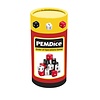- All products are added to your cart.
These unique dice feature numbers, fractions, operations, parentheses and equal
signs. Game includes 30 unique color-coded PEMDice, activity guide with a variety of game options and shaker.
For two students.
Ideas for Middle School Teachers:
In a middle-school setting, PEMDice can first be played with the two advanced-operators cubes removed (the roots/exponent/factorial-cubes). Playing the game with just the13 cubes naturally promotes the use of parentheses. Using parentheses is easy--and desirable because it boosts the score. Players are forced to check and think about whether the parentheses are needed. Remind students that they can multiply by placing a number outside the parentheses (e.g. 3(2+5) instead of 3x(2+5). Once students see how the game works, the two advanced-operator cubes could be added back in.
Ideas for High School Teachers:
Playing PEMDice with all the dice "wild" at first will provide a quick review of why parentheses are essential in many equations. It is also can be a quick warm-up activity at the start of class--or at the end when some students have a few minutes of free time. By playing the game with fixed numbers, but continuing to allowing the operator cubes to all be wild, will let students naturally gain greater proficiency with the operators. At the high-school level, it is helpful to give players a help sheet of "special numbers" that features all the simple perfect squares (1, 4, 9, 16, ...) and cubes (1, 8, 27, 64, 125) as well as the first few factorials. When playing PEMDice at the advanced level, players quickly learn the value of creating "1's" (e.g. (2^3-7) because it allows easy use of the advanced-operators.









